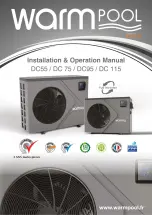
Page
28
Refrigerant piping
Connection
Oil traps
CAUTION
If oil flows back into the outdoor unit’s
compressor, this might cause liquid
compression or deterioration of oil return.
Oil traps in the rising gas piping can prevent
this.
An oil trap should be installed every 6m(20ft)
of vertical suction line riser
(
<
36000Btu/h unit).
An oil trap should be installed every
10m(32.8ft) of vertical suction line riser
(≥36000Btu/h unit).
10m/32.8ft
(≥36000Btu/h unit)
6m/20ft
(
<
36000Btu/h unit)
10m/32.8ft
(≥36000Btu/h unit)
6m/20ft
(
<
36000Btu/h unit)
Indoor unit/
Outdoor unit
Indoor unit/
Outdoor unit
2. Using a pipe cutter, cut the pipe a little longer
than the measured distance.
3. Make sure that the pipe is cut at a perfect 90°
angle.
Oblique Rough Warped
90°
DO NOT DEFORM PIPE
WHILE CUTTING
Be extra careful not to damage, dent, or
deform the pipe while cutting. This will
drastically reduce the heating efficiency
of the unit.
Step 2: Remove burrs.
Burrs can affect the air-tight seal of refrigerant
piping connection. They must be completely
removed.
1. Hold the pipe at a downward angle to
prevent burrs from falling into the pipe.
Step 1: Cut pipes
When preparing refrigerant pipes, take extra
care to cut and flare them properly. This will
ensure efficient operation and minimize the
need for future maintenance.
1. Measure the distance between the indoor
and outdoor units.
CAUTION
•
The branching pipe must be installed
horizontally. An angle of more than 10° may
cause malfunction.
•
DO NOT
install the connecting pipe until
both indoor and outdoor units have been
installed.
•
Insulate both the gas and liquid piping to
prevent water leakage.
Connection Instructions –
Refrigerant Piping











































